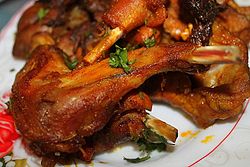Algerian cuisine
| Cuisine of Algeria | |
|---|---|

Grilled rabbit of Algeria
|
|
| Standard Arabic | |
| Abjad | المطبخ الجزائري |
| Romanization | Al-Maṭbakh al-Jazā’irī |
| Algerian Arabic | |
| Abjad | الكوزينة تاع دزاير |
| Latin | El Couzina ta3 Dzaïr |
| Tamazight | |
| Tifinagh | ⵜⴰⴽⵓⵣⵉⵏⵜ ⵏ ⴷⵣⴰⵢⴻⵔ |
| Latin | Takuzint n Dzayer |
| Abjad | ثاكوزينت ن زّاير |
| French | |
| French | Cuisine algérienne |
| IPA | [kɥizin alʒeʁjɛn] |
The cuisine of Algeria is a distinct fusion of Berber, Al-Andalous, Mediterranean and Ottoman cuisine.
Algerian cuisine differs slightly from region to region. Every region has its own cuisine, including Kabylie, Algiers (couscous) and Constantine. Algerian Cuisine is influenced by various cultures such as Berber, Arabic and French. Most of the Algerian dishes are centered around lamb or beef, olive oil, fresh vegetables and fresh herbs. Traditionally, no Algerian meal is complete without bread, normally a long French baguette or more traditionally a flat semolina bread. Pork consumption is forbidden to devout Muslim inhabitants of Algeria in accordance with Sharia, religious laws of Islam.
Algeria, like other Maghreb countries, produces a large range of Mediterranean fruits and vegetables and even some tropical ones.Lamb is commonly consumed. Mediterranean seafood and fish are also eaten and produced by the little inshore fishing.
Algerians consume a high amount of meat, as it is found in almost every dish. Mutton is the most eaten meat in the country, Poultry and beef are also used, other uncommon types of meat such as game, birds and venison and they are considered a delicacy, wild boar is also hunted and eaten, but pork will not be available on stores, you can only buy it from hunters directly, or have it served in some modern restaurants.
Vegetables that are commonly used include potatoes (batata/betetè), carrots (zrodiya), onions (bsel), tomatoes (tomatish/tømètish), zucchini (corget/qar'a), garlic (ethom), cabbages (cromb), and eggplant (badenjan). Olives (zéton) are also used.
...
Wikipedia
